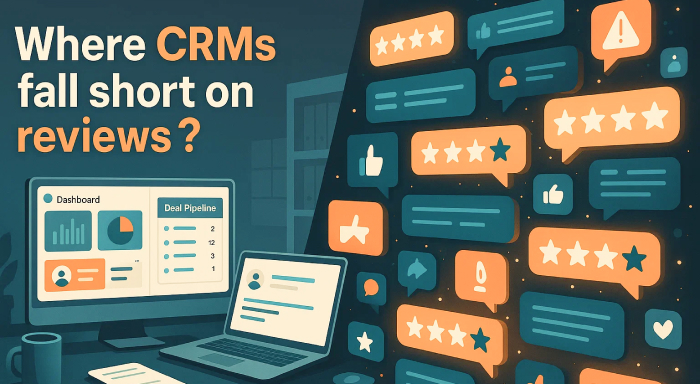Customer reviews are no longer just something nice to have. For sellers in marketplace and direct channels, reviews help them by shaping search visibility, conversation rates, and long-term reputation. CRM is crucial for tracking leads, customer conversations, and repeat business, but reviews are from different places and require different actions. Incorporating review management into your CRM turns dispersed feedback into predictable workflows and measurable results.
Where CRMs fall short on reviews

CRMs are focused on contacts, deals, and predictable workflows. Reviews are messy. They appear on marketplace pages, third-party sites, and social platforms. They are often unstructured, sometimes anonymous, and occasionally urgent. A CRM can store notes about a complaint, but without automated review detection and tagging, your team will miss the signal or respond too late.
A few practical gaps you will see if you leave reviews outside the CRM:
- No central alerting. Someone has to manually find new reviews.
- No automatic triage. A negative review does not become a support ticket automatically.
- No historical link to the buyer’s record for quick resolution.
- No data for product teams to spot recurring defects.
To close these gaps, you must select the appropriate review tool and integrate it with the CRM in a way that generates tasks that your team can complete.
What a good integration actually does
A helpful integration does three things well: discovery, context, and action. Discovery means the tool monitors the channels that matter and feeds new reviews into the CRM in near real time. Context means the tool tags reviews with sentiment, keywords, and urgency so teams can prioritize. Action means the review becomes a ticket, assigned to an owner, with a clear remediation path.
A well-designed flow looks like this: the review scanner finds a negative review and tags it for a product defect. The CRM creates a support ticket, assigns it to an agent, and triggers a warranty or recovery offer. The record stays on the customer timeline, so future interactions are informed by resolution history.
A practical quote and example
“When a listing drops in rating overnight or a cluster of complaints appears, a fast alert matters. Using an integrated scanner, such as an amazon review checker gives you immediate context and lets the CRM treat the alert as a ticket. That means faster recovery, fewer refunds, and better visibility for operations.”
How to pick the right review tool
Coverage and intelligence are the two most important features to look for. Coverage means the tool watches the marketplaces and channels that your SKUs actually appear on. Intelligence means it turns raw text into tags and urgency. For Amazon sellers, you will want marketplace-level scanning, alerting on velocity changes, and pattern detection for suspicious reviews.
Do not pay for features you will not use. If you sell a few SKUs, choose a tool that focuses on depth for those listings rather than a broad but shallow monitoring suite.
Four simple workflows to implement now
Once you have a tool and integration plan, keep workflows lean and human.
- Immediate triage
When a negative review is detected, create a ticket in the CRM with the review text, listing link, and sentiment score. Assign a single agent to respond within 24 hours.
- Root cause loop
If three reviews mention the same issue within a two-week window, escalate to operations. Open a root cause ticket with evidence attached and request a supplier or fulfillment review.
- Recovery and follow-up
For verified buyers, offer a tailored recovery path. That could be a replacement, a refund, or a troubleshooting call. After resolution, follow up publicly if the platform allows. Track whether the review was updated or whether conversions improved.
- Amplification of positives
Positive reviews should not be ignored. Tag them for marketing amplification. Trigger social posts or include them in product pages. Add the reviewer to a VIP list for future promotions.
Metrics to measure success
Make sure the CRM dashboard shows these KPIs:
- Time to first response on negative reviews.
- Percentage of reviews resolved within the SLA.
- Conversion rate change for remediated listings.
- Number of root cause actions opened per month.
These metrics let you show stakeholders that review work is not busywork. It drives measurable improvements in listing health and margins.
Compliance and marketplace rules
Be careful with incentives. Marketplaces have strict rules about asking for review changes or offering incentives to alter public feedback. Your playbook should be compliant by default. Use private recovery paths to resolve issues and then, if permitted, politely request an update. Always record the communication in the CRM for audit and quality control.
Practical implementation steps you can take this week
- Audit where reviews appear for your top 10 SKUs. List the marketplaces and third-party sites.
- Pick up a review scanner that covers those channels and try it on a small set.
- Plan a simple CRM workflow: Find review, create ticket, assign agents, and record resolution.
- Train agents in the short playbook: sample scripts, escalation contacts, and recovery offers.
- Monitor the four KPIs above and adjust the workflows after two weeks.
Why integration pays off
When review signals live in the CRM, your business gains coherence. Support becomes faster, operations spot recurring issues sooner, and marketing can amplify good experiences. The downstream benefit is higher conversion and fewer refunds. The cost of a decent review scanner and a small workflow redesign is modest compared with the lost sales and reputational damage of unattended feedback.
Final thought
A CRM is a powerful foundation. One of the most straightforward ways that customers can tell you about your goods and services is through reviews. Consider them data rather than noise. Integrate review detection with CRM



